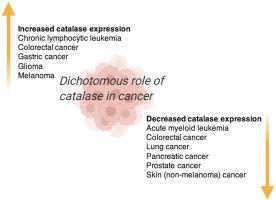Free Radical Biology and Medicine ( IF 7.1 ) Pub Date : 2021-06-12 , DOI: 10.1016/j.freeradbiomed.2021.06.010 Marilisa Galasso 1 , Simona Gambino 2 , Maria Grazia Romanelli 2 , Massimo Donadelli 2 , Maria Teresa Scupoli 3

|
Aerobic organisms possess numerous antioxidant enzymatic families, including catalases, superoxide dismutases (SODs), peroxiredoxins (PRDXs), and glutathione peroxidases (GPXs), which work cooperatively to protect cells from an excess of reactive oxygen species (ROS) derived from endogenous metabolism or external microenvironment. Catalase, as well as other antioxidant enzymes, plays an important dichotomous role in cancer. Therefore, therapies aimed at either reverting the increased or further escalating catalase levels could be effective, depending on the metabolic landscape and on the redox status of cancer cells. This dichotomous role of catalase in cancers highlights the importance to deepen comprehensively the role and the regulation of this crucial antioxidant enzyme. The present review highlights the role of catalase in cancer and provides a comprehensive description of the molecular mechanisms associated with the multiple levels of catalase regulation.
中文翻译:

浏览最古老的抗氧化酶:过氧化氢酶及其在癌症中的多重调控
好氧生物具有许多抗氧化酶家族,包括过氧化氢酶、超氧化物歧化酶 (SOD)、过氧还蛋白 (PRDX) 和谷胱甘肽过氧化物酶 (GPX),它们协同工作以保护细胞免受内源性代谢产生的过量活性氧 (ROS) 或外部微环境。过氧化氢酶以及其他抗氧化酶在癌症中起着重要的二分作用。因此,根据代谢情况和癌细胞的氧化还原状态,旨在恢复增加或进一步升高的过氧化氢酶水平的疗法可能是有效的。过氧化氢酶在癌症中的这种二分作用凸显了全面深化这种关键抗氧化酶的作用和调节的重要性。


















































 京公网安备 11010802027423号
京公网安备 11010802027423号